My painting carries with it the message of pain.
― Frida Kahlo
Frida Kahlo was no stranger to pain. As much as she was known for her skills as a painter, she is also known for her remarkable endurance and strength under horrific medical and personal conditions. The victim of polio at the age of 6, a tram accident at 18 that rendered her unable to bear children, the wife of a cheating husband, the survivor of gangrene and multiple illnesses, she lived most of her life in a state of unbearable pain and misery.
She did not succumb, however. Instead, she painted.
“Painting completed my life. I lost three children and a series of other things that would have fulfilled my horrible life. My painting took the place of all of this.”
While many of us may be fortunate to never experience the horrific accidents and injuries Frida sustained, all women can relate to Frida’s strength in the face of pain. They can also relate to her need to give love to those around her. And in the process of giving love, enduring even more pain.
If sometimes you suffer, I want to fill you with tenderness so that you feel better. When you need me you will always find me near you. Waiting for you always. And I would like to be light and subtle when you want to be alone.
— Frida Kahlo, in a letter to José Bartoli, October 20, 1946
All women can empathize with the many emotions Frida experienced. From anger to hurt to jealousy to feeling of emptiness and madness, we’ve all been there. We’ve all felt a stranger in our own bodies, to the one we lie next to and to the world itself. Fortunately, we have women like Frida who came before us to help us understand our pain. Through her paintings, Frida reflects the inner turmoil of every woman.
The painting descriptions are taken from FridaKahlo.org
The Pain of Identity
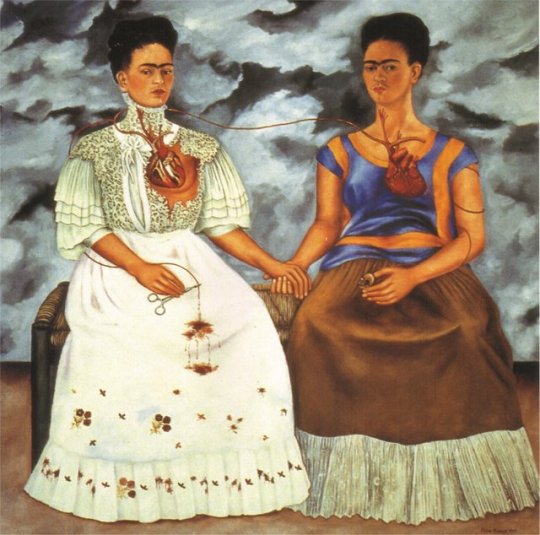
The Two Fridas, 1939
This painting was completed shortly after her divorce with Diego Rivera. This portrait shows Frida’s two different personalities. One is the traditional Frida in Tehuana costume, with a broken heart, sitting next to an independent, modern dressed Frida. In Frida’s dairy, she wrote about this painting and said it is originated from her memory of an imaginary childhood friend. Later she admitted it expressed her desperation and loneliness with the separation from Diego.
In this painting, the two Fridas are holding hands. They both have visible hearts and the heart of the traditional Frida is cut and torn open. The main artery, which comes from the torn heart down to the right hand of the traditional Frida, is cut off by the surgical pincers held in the lap of the traditional Frida. The blood keeps dripping on her white dress and she is in danger of bleeding to death. The stormy sky filled with agitated clouds may reflect Frida’s inner turmoil.
The Physical Pain of Womanhood
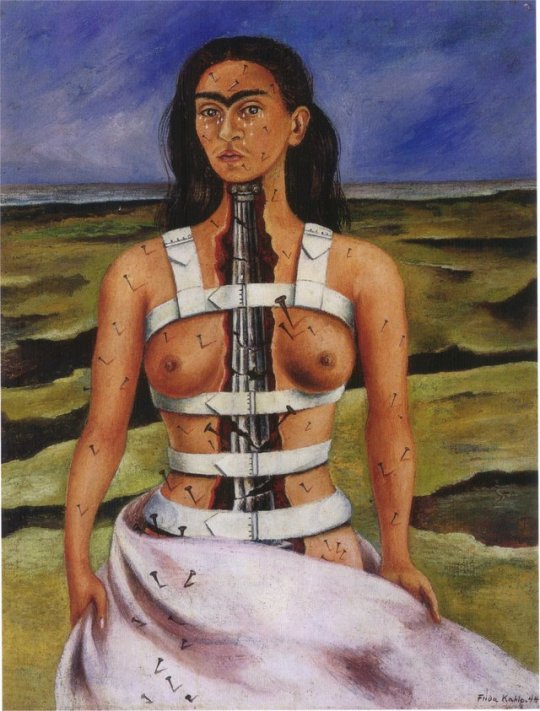
The Broken Column, 1944
In this painting, The Broken Column, Frida expressed her anguish and suffering in a most straightforward and horrifying way. The nails are stuck into her face and whole body. A split in her torso which looks like an earthquake fissure. In the background is the earth with dark ravines. At the beginning she paint herself nude but later covered her lower part up with something looks like a hospital sheet. A broken column is put in place of her spine. The column appears to be on the verge of collapsing into rubble. Penetrating from loins to chin, the column looks phallic, and the sexual connotation is all the more obvious because of the beauty of Frida’s breasts and torso.
This painting Frida looks pretty and strong. Although her whole body is supported by the corset, she is conveying a message of spiritual triumph. She has tears on her face but she look straight ahead and is challenging both herself and her audience to face her situation.
The Pain of Betrayal
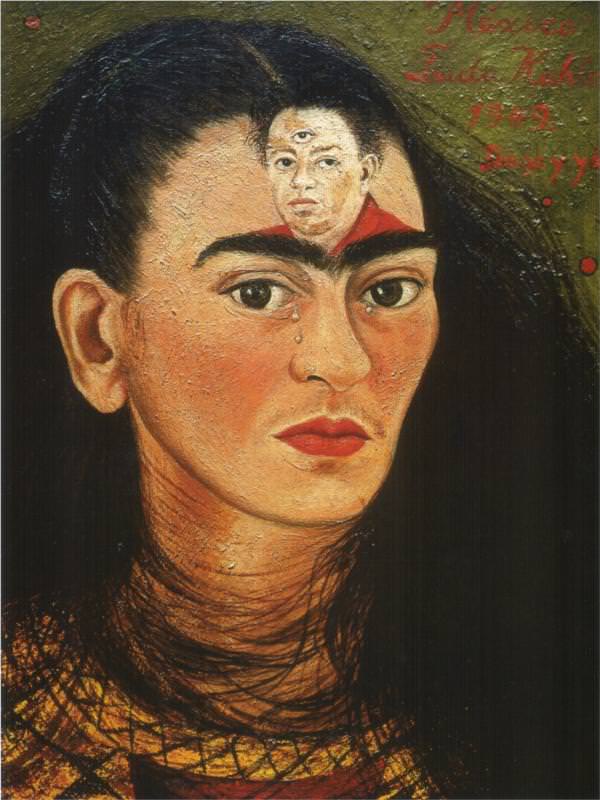
Diego and I, 1949
“Perhaps it is expected that I should lament about how I have suffered living with a man like Diego. But I do not think that the banks of a river suffer because they let the river flow, nor does the earth suffer because of the rains, nor does the atom suffer for letting its energy escape. To my way of thinking, everything has its natural compensation.”
This painting shows Frida’s great anguish over Diego Rivera. When he had an affair with Maria Felix he almost divorced Frida. Maria Felix was a beautiful film star and as well an intimate friend of Frida. Even though Frida was trying to joke about this affair, as she always did with Rivera’s other affairs, Diego and I shows that she was deeply hurt. In this paint she is has loose hair swirling around her neck which indicates strangulation. She lost her mask of reserve. It’s obvious that the cause of her distress is her husband Diego, for which her eyebrows serve as platform. And a third eye, which alludes to Rivera’s prevalent mental and visual keenness, opens in her spouse’s brow. Of the pyramid of five eyes that post of this painting, just Frida’s meet our own. Diego, whose creative venue was surrounding and epic, gazes out over viwer’s heads into the past.
That Rivera was always in Frida’s thoughts is revealed also in her dairy, much of which is a love poem to him: “DIEGO. I am alone.” Then a few pages later: “My Diego. I am no longer alone. You accompany me. You put me to sleep and you revive me.” Another time she drew two faces that look like vases. “Don’t cry at me,” one of them says. The other answers: “Yes. I’ll cry at you.” In a more romantic moment, she wrote: “Diego: Nothing is comparable to your hands and nothing is equal to the gold-green of your eyes. My body fills itself with you for days and days. You are the mirror of the night. The violent light of lightning. The dampness of the earth. Your armpit is my refuge. My fingertips touch your blood. All my joy is to feel your life shoot forth from your fountain-flower which mine keeps in order to fill all the paths of my nerves which belong to you.”
The Pain of Being Strong
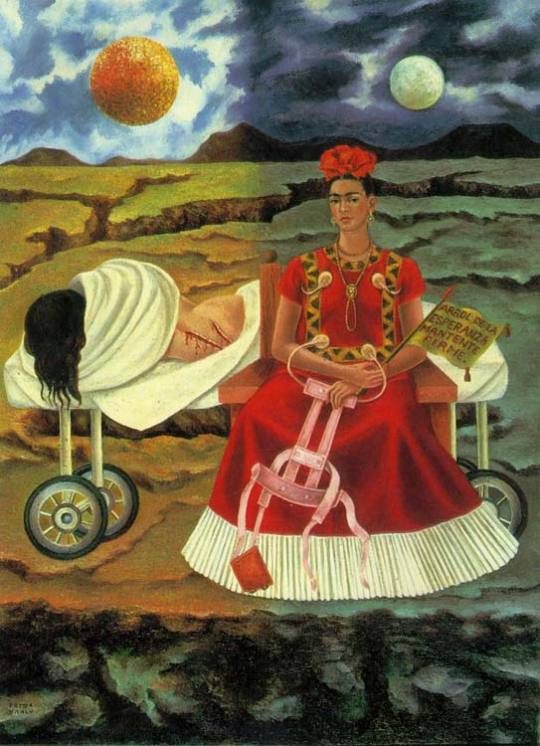
Tree of Hope, Remain Strong, 1946
Frida painted this self-portrait for her patron, the engineer Eduardo Morillo Safa, after a botched operation in New York. She wrote to him about the painting and about the scars “…which those surgeon sons of bitches landed me with”. In the message “Tree of Hope, Remain Strong”, which is written on her flag, she seems to be giving herself courage. The phrase is taken from one of her favorite songs, “Cielito Lindo”.
In this painting we see two Fridas; the one on the left is the Frida who has just been rolled out of the operating room on a hospital trolley and the other is the forceful, upright and confident figure of Frida. The painting is divided into two halves, one day and one night. The maimed and bleeding body is assigned to the sun, which in Aztec mythology the sun is fed by sacrificial human blood. The two gaping wounds in her back are echoed in the fissures in the barren landscape behind. The other Frida, looking strong and optimistic, is assigned to the moon, a symbol of womanhood. In her hand she holds the corset that she has “Hope” of casting off forever after the surgery. Unfortunately, this surgery was terribly botched and resulted in numerous complications. It has been described as “the beginning of the end” for Frida.
The Pain of A Life Not Fully Lived
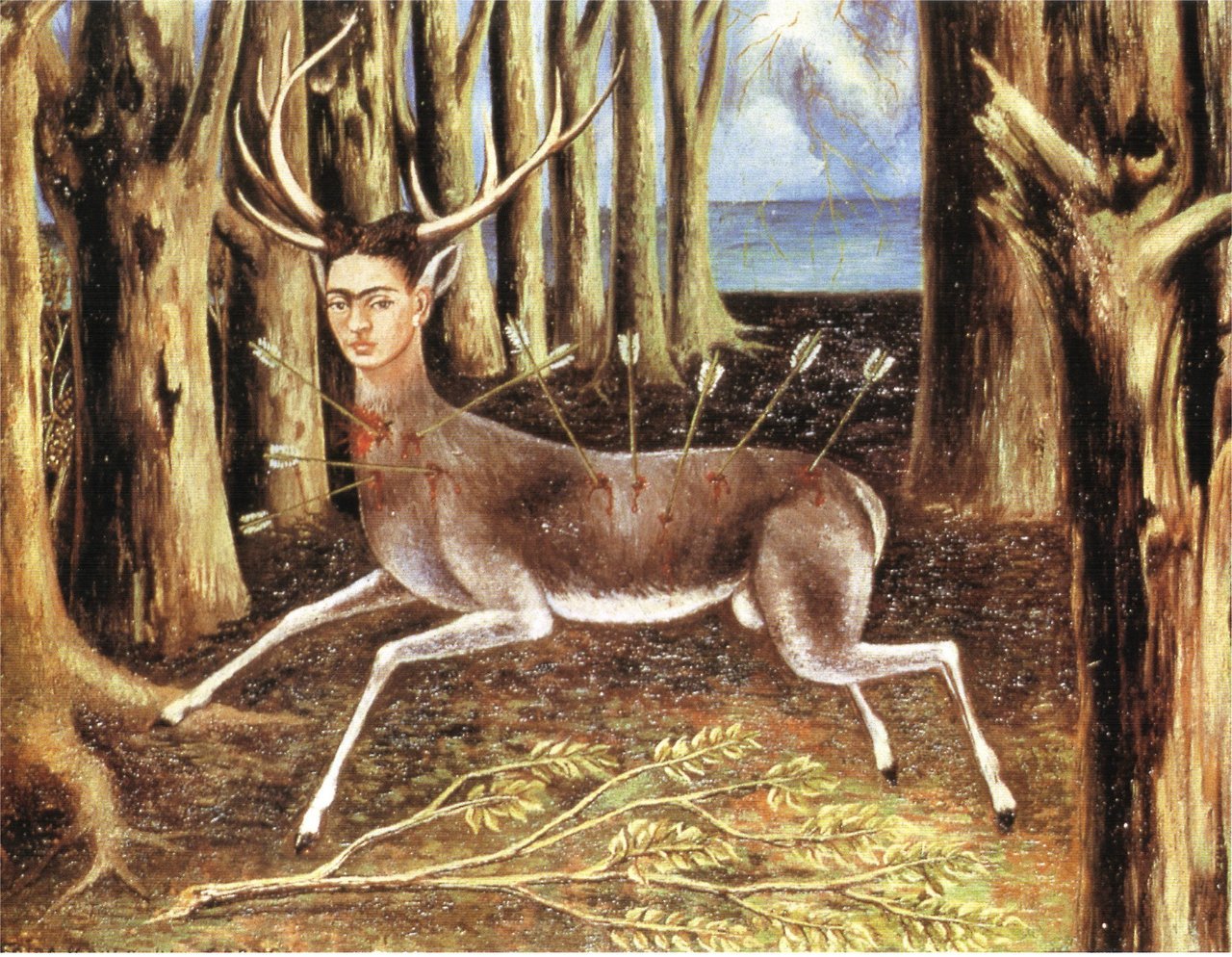
The Wounded Deer, 1946
In this painting, Frida used a young deer with the head of herself. The background is the forest with dead trees and broken branches, which implied the feeling of fear and desperation. Far away is the stormy, lightning-lit sky which brings some hope but the deer will never be able to reach it.
In 1946 Frida Kahlo had an operation on her spine in New York. She was hoping this surgery would free her from the severe back pain but it failed. This painting expressed her disappointment towards the operation. After she went back to Mexico, she suffered both the physical pain and emotional depression. In this painting she depicted herself as a young stag with her own head crowned with antlers. This young stag is pierced by arrows and bleeding. At the lower-left corner, the artist wrote down the word “Carma”, which means “destiny” or “fate”. Just like her other self-portraits, in this painting Frida expressed the sadness that she cannot change her own fate.
Frida used her pet deer “Granizo” as the model when she painted this portrait. She had many pets which she used as her surrogate children and deer is her favorite kind.
This painting has multiple interpretations from different people. Some said it expressed her frustration over the botched surgery. Others said it portrays her incapability to control her own destiny. And some people said it has sexual implication and expressed her struggles in different relationship.
The Pain of Losing A Child/Infertility
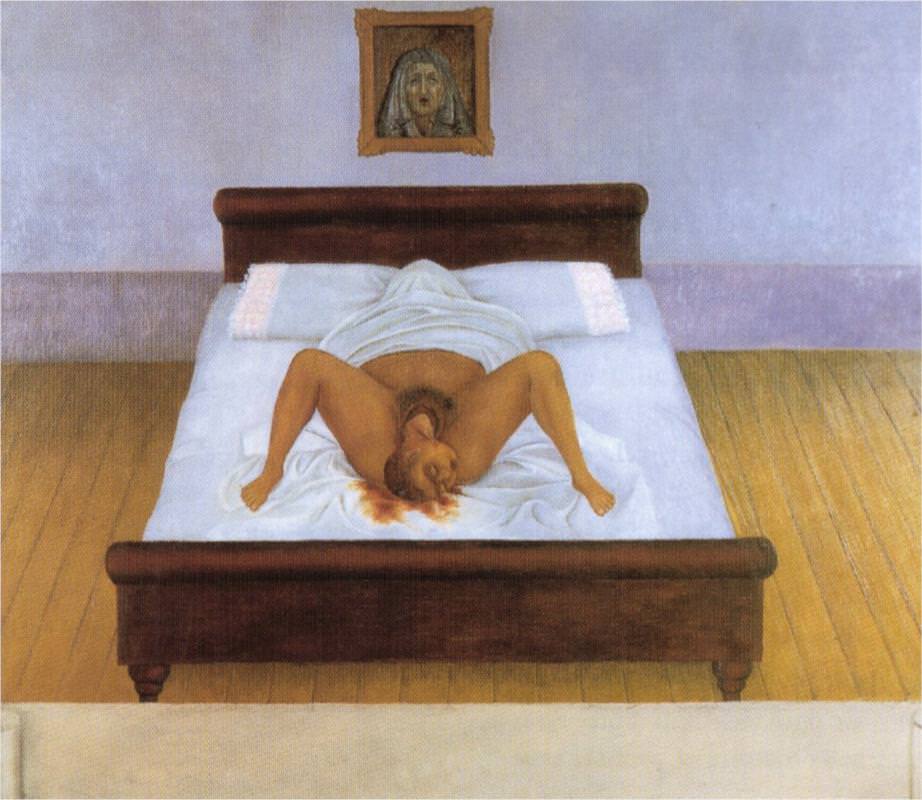
My Birth, 1932
Diego Rivera encouraged her start the project to paint her major life events to a series of painting. This painting is the first one in her series. She remarked this painting is about “…how I imagined I was born.” And in her journal, Frida said this painting depicts she was giving birth to her self.
In this painting, the head of Frida, which is frightening large, is getting out from the mother’s womb. There is a puddle of blood under the mother’s body which might be a hint of Frida’s own experience with the recent miscarriage. A sheet covers the mother’s face, which might be from the recent event of the death of Frida’s mother. Above the birth bed, a picture of weeping “Virgin of Sorrows” is hang above. The Virgin looks on in tears with sorrow and sympathy but seems she can do nothing about the situation.
Although this painting was painted in the style of an “ex-voto retablo”, nothing was written on the unfurled scroll at the bottom. Maybe she felt she could not describe her feeling about a woman undergoing child birth. This painting may have also been influenced by a 16th Century sculpture of the Aztec Goddess Tlazolteotl giving birth to an adult male warrior.
Pop star Madonna collected this painting. In an interview with Vanity Fair, Madonna said she used this painting to tell who is her friend and who is not. “If somebody doesn’t like this painting”, Madonna said, “then I know they can’t be my friend”.
The Pain of Being A Woman In A Man’s World
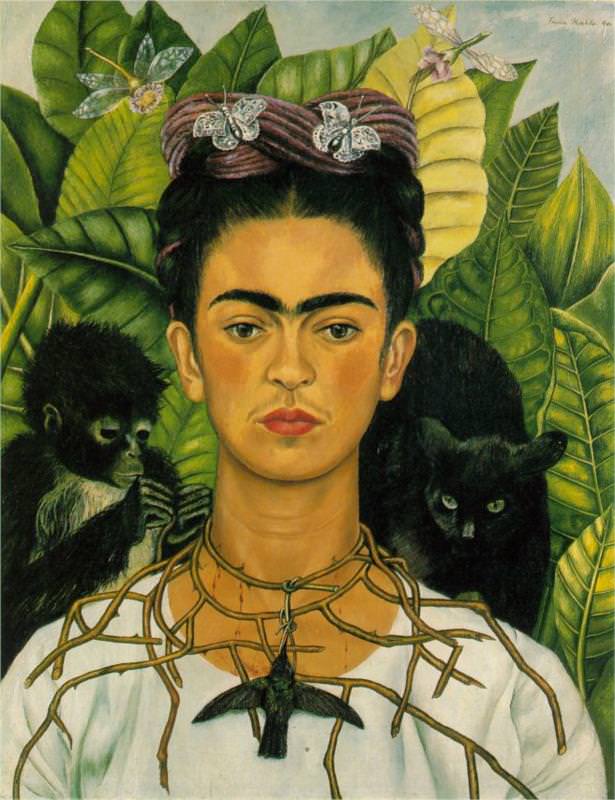
Self-Portrait with Thorn Necklace and Hummingbird, 1940
This painting, Self-Portrait with Thorn Necklace and Hummingbird, was painted by Frida Kahlo in 1940. Although this painting has a small size (about 16×24), it draws lots of interests, since it contains so many aspects which are symbolic to Frida Kahlo. In this portrait, Frida Kahlo faces the viewer with background of large green leaves and a yellow leaf right behind her. The thorns are around her neck like a necklace which is held by a black monkey. Her neck is bleeding from the piercing thorns. On right side behind her shoulder is a black cat. A humming bird is hanging on the thorn which knots around her throat. Her expression is calm and solemn. It also seems she is patiently enduring the pain.
Frida Kahlo put so many symbolic creatures in this painting. She was not painting a realistic scene but using these symbolic elements to express her feelings. A bird is often symbolize freedom and life. Especially hummingbird which is colorful and always hovering above flowers. But in this painting the humming bird is black and lifeless. This might be a symbol of Frida herself. Frida spent most of her life in physical pain after the bus accident happened when she was eighteen. After that she endured about thirty-five operations to fix her body. She spent so many years bedridden and cannot bear any children. This is a painting about her suffering.
